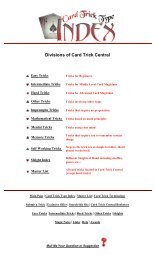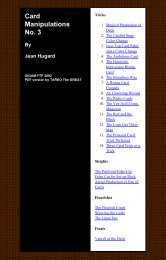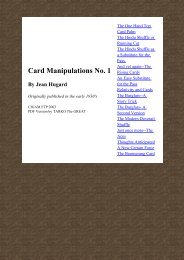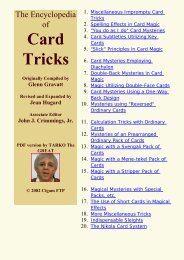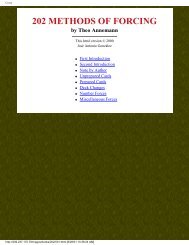Card Manipulations No. 4 By Jean Hugard - Umclidet
Card Manipulations No. 4 By Jean Hugard - Umclidet
Card Manipulations No. 4 By Jean Hugard - Umclidet
You also want an ePaper? Increase the reach of your titles
YUMPU automatically turns print PDFs into web optimized ePapers that Google loves.
<strong>Card</strong> <strong>Manipulations</strong> <strong>No</strong>. 4<br />
<strong>Jean</strong> <strong>Hugard</strong><br />
Next | Previous | Contents<br />
Replacing Palmed <strong>Card</strong>s<br />
a. Using a Table<br />
b. Without a Table<br />
c. On Bottom of Deck<br />
d. Adding a Single <strong>Card</strong> to Deck<br />
e. Large Packet of Palmed <strong>Card</strong>s<br />
f. The Same--Another Method<br />
g. Packet from Right Hand to Bottom of Deck<br />
h. The Same--Another Method<br />
Apart from a casual reference by Erdnase, I do not recall<br />
mention of this important sleight in any of the text books on<br />
card magic. That it is important and a stumbling block to<br />
many card magicians is quite certain. Recently, I saw a<br />
performer, who has a great reputation for his work with<br />
cards, do a trick of the "Take a <strong>Card</strong> Variety". Having<br />
allowed a spectator to choose a card and replace it, he made<br />
the pass very clumsily, palmed the card in his right hand<br />
which he at once put behind his back as he offered the pack<br />
with his left hand to the drawer of the card to be shuffled.<br />
To take the pack back again he extended his left hand to<br />
receive it and then deliberately put his right hand on the<br />
deck replacing the card on top. This clumsy procedure made<br />
his trick quite obvious even to the uninitiated.<br />
The following methods will show how the awkwardness of<br />
taking the pack back with the left hand can be avoided and<br />
the whole action covered by natural movements:<br />
a. Using a Table<br />
When working at or near a table, after bringing the chosen<br />
card to the top, palm it by means of the One Hand Top Palm<br />
(<strong>Card</strong> <strong>Manipulations</strong> <strong>No</strong>. 1) in handing the deck to be<br />
shuffled. When this has been done ask the spectator to place<br />
the deck on the table and cut it. As he lifts off the upper<br />
portion of the pack place your right hand on the remaining<br />
packet and draw it back towards the edge of the table in the<br />
natural way of picking the deck up, adding the palmed card<br />
(or cards) to the top and covering operation with the full<br />
width of the hand.<br />
Take the cut portion from the spectator with your left hand,<br />
place the right hand packet on top of it and square the deck.<br />
These actions are natural and can arouse no suspicions.<br />
The tendency to hold the hand and arm rigidly to the side<br />
when cards have been palmed, must be fought against. The<br />
wrist and arm should be held naturally flexed and be moved<br />
about freely in gestures appropriate to your patter, indeed<br />
the fact that cards are secretly held in the hand should be<br />
forgotten for the moment.<br />
b. Without a Table<br />
When working without a table the best plan is this: A card,<br />
or cards, having been palmed in the right hand and a<br />
spectator having shuffled a pack, hold out your left hand,<br />
fiat and palm upwards, request him to place the deck on it<br />
and then cut at any place he desires. The moment he lifts the<br />
cut portion bring your right hand over the remainder adding<br />
the palmed cards to them and at once bend the right<br />
forefinger inward to the middle of the top of the packet.<br />
Press downwards with this finger and pull the ends of the<br />
cards upwards with the thumb and fingers on the ends, thus<br />
taking the crimp out of the cards that were palmed. Take the<br />
cut portion from the spectator with the left hand and<br />
reassemble the pack.<br />
Here again the action is easy and natural, and so far from<br />
arousing any suspicion in the minds of the spectators, it<br />
tends to impress them that the cut so freely made must make<br />
it certain that the location of any particular card cannot<br />
possibly be known.<br />
c. Replacing <strong>Card</strong>s on the Bottom of the<br />
Deck<br />
The operation in this<br />
case is simple but must<br />
be timed perfectly.<br />
Having palmed a packet<br />
of cards from the bottom<br />
with the left hand, offer<br />
the deck to be shuffled<br />
with your right hand, and<br />
this having been done,<br />
take it back with the<br />
same hand. Bring the two hands together, the left coming up<br />
from the side with its back to the spectators. At the moment<br />
the hands meet turn the left hand palm upwards and with the<br />
right hand place the deck, which holds by the ends, on the<br />
palmed cards. At the same time double the left forefinger<br />
under the deck so that its nail rests against the bottom card,<br />
and run the left thumb and the other three fingers along the<br />
sides of the deck squaring the cards. Fig. 10.<br />
A few trials before a mirror will show the angles necessary<br />
to cover the replacement of the palmed cards.<br />
d. Adding a Single <strong>Card</strong> as in the Color<br />
Change<br />
This sleight is generally done with the pack in the left hand,<br />
the left thumb being held against the side of the deck. It is<br />
much more effective to hold the thumb pressed against the<br />
middle of the deck, so that when the right hand is moved<br />
over the cards, the left thumb is seen to be still pressing on<br />
the middle of the face card, yet the change has been made.<br />
To do this, hold the pack in the left hand, the thumb across<br />
the middle of the face card.<br />
Bring the right hand with<br />
the palmed card towards<br />
the deck, at the same time<br />
press the first joint of the<br />
right hand little finger<br />
against the corner of the<br />
palmed card and push its<br />
opposite diagonal corner<br />
firmly against the base of<br />
the thumb, thus bending<br />
the middle of the card<br />
slightly away from the palm of the hand. Fig. 11<br />
Move the right hand over the deck and, without moving the<br />
left thumb, slide the card under it and leave it there. As the<br />
right hand moves away the left thumb is seen to be still<br />
pressing on the middle of the deck, thus greatly increasing<br />
the effect of the change.<br />
The same method should be used for placing a card, secured<br />
by the Side Slip, on to the top of the pack, the action<br />
apparently being that of merely squaring the deck. The left<br />
thumb should remain on the back of the deck throughout.<br />
This sleight can be used in replacing a small packet of not<br />
more than five or six cards. For any larger number the plan<br />
that follows should be used.<br />
e. To Replace a Large Packet of <strong>Card</strong>s<br />
Hold the pack in the left<br />
hand between the first<br />
joints of the thumb and<br />
second and third fingers,<br />
the first finger being<br />
doubled under the deck<br />
so that its nail presses<br />
against the bottom card.<br />
Turn slightly to the left,<br />
bring the right hand full length over the deck and instantly<br />
grip its ends with the ball of the thumb at the inner end and<br />
the first joints of the second and third fingers at the outer<br />
end, depositing the palmed cards on top of the deck.<br />
Instantly bend the right forefinger inwards so that its tip<br />
rests on the middle of the top card. Press down with<br />
forefinger and pull the ends of the deck slightly upwards, so<br />
taking the bend out of the cards which were palmed. Fig.<br />
12.<br />
f. Another Method<br />
Having cards palmed in the right hand, hold the deck as<br />
described in move <strong>No</strong>. 5. Turn slightly to the left and take<br />
the pack with the right hand by gripping its outer top and<br />
bottom corners between the first joints of the right<br />
forefinger and thumb. The backs of the right hand and the<br />
deck should be towards the front. Making some appropriate<br />
gesture with the left hand allow it to be seen empty and<br />
again take the pack in that hand. At the same moment slide<br />
the right hand over the top of the deck and grip the palmed<br />
pack by its sides with the left thumb and fingers. Slide the<br />
right hand back as if it had merely squared the cards.<br />
g. Placing <strong>Card</strong>s from Right Palm to the<br />
Bottom of the Deck<br />
Proceed as in Move <strong>No</strong>. 6, but instead of sliding the right<br />
hand over the deck, stretch out the left fingers under the<br />
deck and, under cover of the right hand, draw the palmed<br />
cards underneath. To facilitate this transfer, lift the right<br />
hand side of the deck slightly with the right thumb and first<br />
finger. The moment the cards are safely under the deck<br />
make the usual movements with the right hand to square the<br />
cards.<br />
h. Another Method<br />
This sleight can only be used when working at a table. A<br />
packet of cards being palmed in the right hand, to get them<br />
to the bottom, take the deck in both hands by the ends and<br />
make a running cut, i.e. draw off a series of small packets<br />
from the top and drop them on the table. The apparent<br />
removal of the first packet is merely a feint; simply make<br />
the action but take no cards at all, dropping the palmed<br />
cards on the table. Then really make the cuts with precisely<br />
the same action as in the first pretended cut. The palmed<br />
cards thus become the bottom cards of the deck.<br />
Next | Previous | Contents



